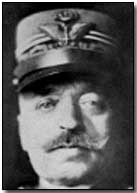Primary Documents - Luigi Cadorna on the Sixth Battle of the Isonzo, 26 December 1916
 Having earlier in the year
resisted the
Austro-Hungarian offensive at Asiago, the Italian Army in early August
resumed their seemingly unending offensive along the Isonzo - in this case
the Sixth
Battle of the Isonzo (also known as the Battle of Gorizia). The
Italian attack this time was directed at the capture of Gorizia.
Having earlier in the year
resisted the
Austro-Hungarian offensive at Asiago, the Italian Army in early August
resumed their seemingly unending offensive along the Isonzo - in this case
the Sixth
Battle of the Isonzo (also known as the Battle of Gorizia). The
Italian attack this time was directed at the capture of Gorizia.
With the Austro-Hungarian lines depleted following their concerted attack earlier in the year (whereas Italian Commander-in-Chief Luigi Cadorna had made efficient use of railways to quickly ferry his own troops back to the Isonzo) and with the additional need to defend against the Russian Brusilov Offensive in the east, Gorizia fell and the Italians succeeded in establishing a bridgehead at last across the Isonzo.
Reproduced below is Cadorna's summary account of the battle.
Official Report by Commander-in-Chief Luigi Cadorna, 26 December 1916
In the spring we sustained in the Trentino the powerful, long-prepared Austrian offensive, which the enemy with insolent effrontery styled a punitive expedition against our country.
But after the first successes, which were due to the preponderance of material means collected, above all in artillery, the proposed invasion was quickly stopped and the enemy was counter-attacked and forced to retire in haste into the mountains, leaving on the Alpine slopes the flower of his army and paying bitterly the price for his fallacious enterprise not only here but also on the plains of Galicia.
Our army did not rest after its wonderful effort. While maintaining a vigorous pressure on the Trentino front, in order to gain better positions and to deceive the enemy as to our intentions, a rapid retransfer of strong forces to the Julian front was made.
In the first days of August began that irresistible offensive which, in two days only, caused the fall of the very strong fortress of Gorizia and of the formidable system of defences on the Carso to the west of the Vallone.
Doberdo, San Michele, Sabotino - names recalling sanguinary struggles and slaughter - ceased to be for the Austro-Hungarian Army the symbols of a resistance vaunted insuperable, and became the emblems of brilliant Italian victories. The enemy's boastful assertions of having inexorably arrested our invasion on the front selected and desired by himself were refuted at one stroke.
From that day our advance on the Carso was developed constantly and irresistibly. It was interrupted by pauses indispensable for the preparation of the mechanical means of destruction without which the bravest attacks would lead only to the vain sacrifice of precious human lives.
Our constant and full success on the Julian front is witnessed by 42,000 prisoners, 60 guns, 200 machine guns, and the rich booty taken between the beginning of August and December.
Also on the rest of the front our indefatigable troops roused the admiration of all who saw them for their extraordinary efforts to overcome not only the forces of the enemy but also the difficulties of nature.
Our soldiers are supported by the unanimous approval of the nation, by faith in themselves and in the justice of their cause. They face willingly their hard and perilous life, under the guidance of their beloved sovereign, who from the first day of the war with a rare constancy has shared their fortunes.
Our army is waiting in perfect readiness to renew the effort which will carry it to the fulfilment of the unfailing destiny of our people.
Source: Source Records of the Great War, Vol. IV, ed. Charles F. Horne, National Alumni 1923
In preparation for the Battle of the Somme, the British launched a seven-day artillery bombardment in which 1,500 guns fired 1.6 million rounds.
- Did you know?
